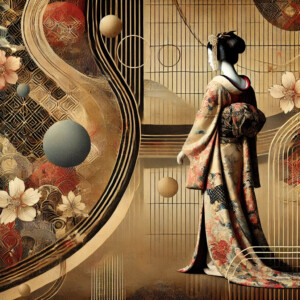The Background of Japanese Contemporary Art and Traditional Culture
The Rise of Contemporary Art
Japanese contemporary art underwent rapid development during the post-World War II reconstruction period. As Japan aimed for cultural revival along with economic growth, many artists began to gain international recognition. Especially in the 1950s and 1960s, avant-garde art groups such as the Gutai Art Association and Mono-ha emerged, exploring new forms of expression distinct from traditional art. These artists maintained Japan’s unique aesthetic while incorporating elements of Western art movements such as abstract expressionism and performance art.

The Role of Kimono as Traditional Culture
The History and Symbolism of Kimono
Kimono has deep roots in Japanese culture and daily life, with origins dating back to the Nara period (710-794). During the Heian period (794-1185), kimono evolved into a sophisticated fashion item among the aristocracy. The design, color, and pattern of kimono vary according to the season, ceremony, and social status, representing the diversity and beauty of Japanese aesthetics. Even today, kimono plays a significant role in special events such as coming-of-age ceremonies, weddings, and tea ceremonies. The materials and techniques of kimono are closely related to traditional crafts such as embroidery and dyeing, requiring high levels of craftsmanship in their production.

The Influence of Kimono in Contemporary Art
Contemporary Artworks Inspired by Kimono
Many contemporary artists create works themed around kimono. For instance, Yayoi Kusama frequently features polka dots reminiscent of kimono patterns in her works. Hiroshi Sugimoto’s photographic series “Kiyozu” explores the dialogue between the past and present by capturing individuals wearing kimono. These artworks reinterpret the traditional beauty of kimono from a contemporary perspective, creating new expressions. Additionally, some fashion designers incorporate elements of kimono into modern designs, promoting the charm of kimono worldwide.
The Popularity of Japanese Contemporary Art and Kimono in the United States
American Interest in Japanese Culture
In the United States, interest in Japanese culture is growing, particularly in kimono and contemporary art. Major cities like New York and Los Angeles frequently host exhibitions of Japanese contemporary art and kimono shows, attracting large audiences. For example, the Metropolitan Museum of Art held a special exhibition titled “Japanese Fashion: From Modern to Traditional,” showcasing the history and contemporary interpretation of kimono. In the American fashion industry, designs inspired by Japanese kimono are also popular, with many celebrities wearing kimono-style dresses.
The Future of Kimono and Contemporary Art
Prospects for the Future
The fusion of kimono and contemporary art holds potential for creating new forms of expression. As tradition and innovation intersect, artists continue to explore creative challenges. For instance, digital technology is being used to design kimono, and installation art incorporating kimono is expanding possibilities in the future art scene. Furthermore, through international exchange, the appeal of Japanese contemporary art and kimono is expected to reach a broader audience, fostering new cultural developments.

Comment